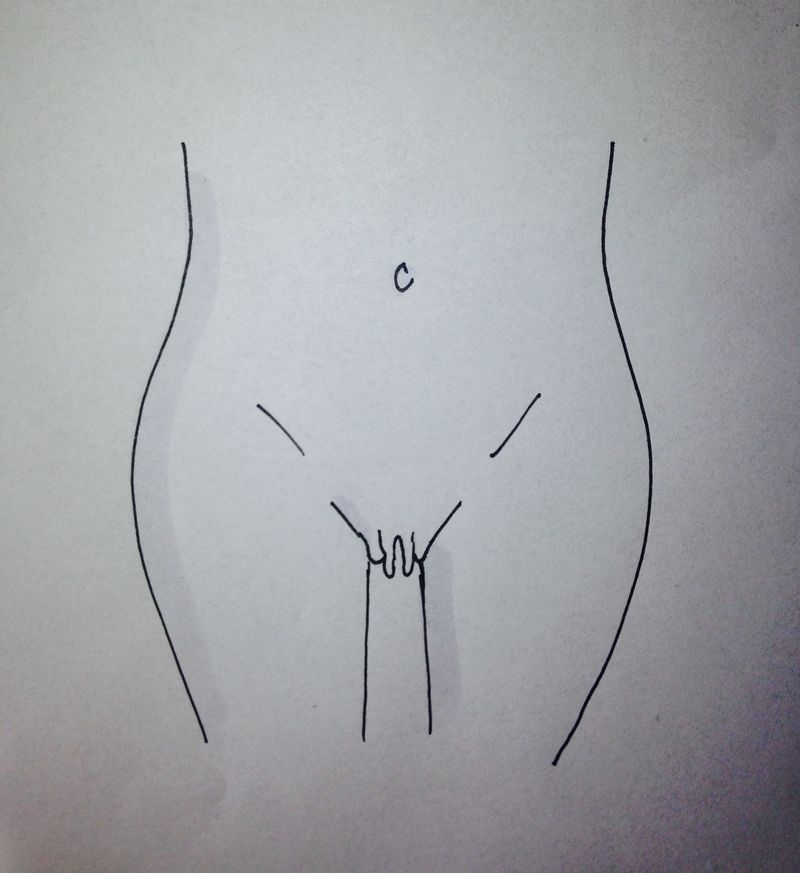Understanding 'Outie' Vulvas: A Guide to Anatomy, Diversity, and Body Image

Key points
- Labia Majora: The larger, outer fleshy "lips" that are typically covered with pubic hair after puberty.
- Labia Minora: The smaller, inner "lips" located inside the labia majora.
The term "outie coochie" is a colloquial phrase used to describe a specific and completely normal type of female anatomy. While informal, its frequent use in search queries highlights a common curiosity and, for many, a source of personal anxiety about what is "normal." This article aims to provide a comprehensive, medically-informed, and compassionate guide to understanding vulva diversity, moving beyond slang to explore the science, psychology, and societal pressures surrounding genital appearance.
Our goal is to debunk myths, provide clarity using correct anatomical terms, and empower you with the knowledge that all bodies are unique and valid.
What Exactly is an "Outie"? Deconstructing the Anatomy
When people use the terms "innie" or "outie," they are referring to the appearance of the vulva, which is the external part of the female genitalia. It's important to distinguish this from the vagina, which is the internal muscular canal.
The key structures involved are the labia:
- Labia Majora: The larger, outer fleshy "lips" that are typically covered with pubic hair after puberty.
- Labia Minora: The smaller, inner "lips" located inside the labia majora.
An "outie" vulva is simply one where the labia minora (inner lips) are longer and protrude beyond the labia majora (outer lips), making them visible. Conversely, an "innie" vulva is where the labia minora are smaller and fully enclosed by the labia majora.
According to Dr. Michael Tahery, an OB-GYN and urogynecologist, an outie refers to a vulva with inner lips that are visible from the outside, which can vary drastically in shape and size. This is a natural variation, not a medical condition.
Is an "Outie" Vulva Normal? The Science of Diversity
Yes, absolutely. An "outie" vulva is not only normal but also very common. A 2017 study found that 56% of vulvas have visible labia minora, suggesting that "outies" are slightly more prevalent than "innies."
Female anatomy is incredibly diverse. Vulvas come in a vast array of shapes, sizes, colors, and levels of symmetry. The lifestyle magazine Cosmopolitan highlighted several common types, including:
- Asymmetrical Inner Lips: Where one side of the labia minora is longer than the other.
- Prominent Inner Lips: The classic "outie" appearance, which they note is the most common type.
- Curved Outer Lips: Where the labia majora curve, exposing the inner lips.
Every vulva is unique. Resources like the Labia Library, an online photo gallery, were created to showcase this diversity and reassure people that there is no single "correct" way for a vulva to look.
 Source: Emma Ledger / Cosmopolitan UK
Source: Emma Ledger / Cosmopolitan UK
The Biology Behind Labia Shape and Size
The shape and size of your labia are determined by a combination of genetics and hormonal changes throughout your life. They are not influenced by sexual activity, number of partners, or hygiene habits.
- Puberty: The surge of estrogen during puberty causes the labia minora and majora to grow and become more prominent. This is when the characteristics of an "innie" or "outie" often become apparent.
- Genetics: Just like other physical traits, the final shape, size, and color of your labia are largely dictated by your genetic makeup.
- Pregnancy and Aging: Hormonal shifts during pregnancy and the natural aging process can also lead to changes in the appearance and elasticity of the labia.
Understanding the biological basis helps to dismantle harmful myths and reinforces that an "outie" is a natural outcome of development, not a sign of any particular behavior or health issue.
Societal Pressures and the Psychological Impact
Despite its prevalence, the "outie" vulva is often underrepresented or stigmatized in mainstream media and pornography, which frequently promotes a narrow, uniform "Barbie-like" ideal where the labia minora are completely hidden. This lack of representation has led to significant psychological distress for many.
This issue was thrust into the spotlight when podcaster Brooke Schofield shared a deeply personal experience on the "Cancelled with Tana Mongeau" podcast. She revealed that comedian Matt Rife, hours after they had been intimate, publicly stated on another podcast that he was "disgusted" by "outie" vaginas.
Schofield courageously shared her story, stating, "I, Brooke Schofield, have an ‘outie’ vagina, OK? And so do f—king two-thirds of America!" Her experience highlights the real-world harm of such body-shaming. It can lead to:
- Low Self-Esteem and Body Dysmorphia: Feeling that one's body is flawed or abnormal.
- Sexual Anxiety: Heightened self-consciousness during intimacy and avoidance of situations where the genitals might be visible.
- Reduced Sexual Satisfaction: Worry and anxiety can detract from pleasure and confidence.
These feelings are a direct result of unrealistic societal standards, not a problem with the body itself.
 Podcaster Brooke Schofield (left) with co-host Tana Mongeau. Schofield's experience brought mainstream attention to the issue of vulva shaming. Source: Christopher Polk / Getty Images via HuffPost
Podcaster Brooke Schofield (left) with co-host Tana Mongeau. Schofield's experience brought mainstream attention to the issue of vulva shaming. Source: Christopher Polk / Getty Images via HuffPost
Functional Concerns vs. Aesthetic Anxieties
It is crucial to differentiate between genuine physical discomfort and psychological distress stemming from aesthetic concerns.
Functional Health Implications
In some rare cases, a condition known as labial hypertrophy (where the labia minora are disproportionately large) can cause physical issues. According to Medical News Today, these can include:
- Pain or chafing during sports, such as cycling or running.
- Irritation from tight clothing.
- Discomfort during sexual intercourse.
- Difficulty with hygiene.
If you are experiencing persistent physical pain or discomfort, it is important to speak with a healthcare provider, like a gynecologist, to discuss your symptoms and potential solutions.
Aesthetic Concerns
For the vast majority of individuals, concerns about an "outie" are purely cosmetic and driven by the societal pressures discussed above. Feeling self-conscious is a valid emotional response to these pressures, but it doesn't mean your body is flawed.
Considering Labiaplasty
For those with significant functional issues or severe, persistent psychological distress, labiaplasty is a surgical option. This procedure reduces the size of the labia minora. While patient satisfaction rates are often high, it's essential to approach this decision carefully.
Before considering surgery for cosmetic reasons, it's beneficial to:
- Educate Yourself: Explore resources that show anatomical diversity to normalize your own appearance.
- Consult a Medical Professional: Speak with a board-certified gynecologist or plastic surgeon to understand the risks, benefits, and whether surgery is truly the right path for your specific concerns.
- Consider Therapy: A therapist specializing in body image or sexual health can help you navigate feelings of self-consciousness and build self-esteem.
Embracing Body Positivity and Finding Support
Overcoming insecurity about your body is a journey. The first step is recognizing that diversity is the norm.
- Challenge Unrealistic Standards: Be critical of the media you consume. Recognize that many images are curated to fit a narrow ideal.
- Practice Self-Acceptance: Your body's appearance is a part of who you are. Focus on its function, strength, and capacity for pleasure.
- Communicate: If you feel comfortable, talking with a trusted partner can alleviate anxiety. Often, partners are far less critical of our bodies than we are of ourselves.
- Seek Professional Support: If feelings of shame or anxiety are impacting your quality of life, a therapist can provide invaluable tools and support.
Ultimately, whether you have an "innie," an "outie," or something in between, your body is normal and deserving of acceptance and respect.
References
- Dr. Michael Tahery. (2024). Innie Vs Outie Vagina | Which One is Normal? drtahery.com
- Fletcher, J. (2021). Innie vs. outie vagina: What are the differences? Medical News Today. medicalnewstoday.com
- Yoxly. (2024). “Innie” Vs “Outie” Vaginas. yoxly.com
- Harvey-Jenner, C., & Williams, S. (2025). "Is my vagina normal?" Yes! Here are the 7 different types of vaginas. Cosmopolitan UK. cosmopolitan.com
- Moreno, A. (2023). Podcaster Says Matt Rife Publicly Body-Shamed Her Hours After Sleeping With Her. HuffPost. huffpost.com

About the author
Sofia Rossi, MD, is a board-certified obstetrician-gynecologist with over 15 years of experience in high-risk pregnancies and reproductive health. She is a clinical professor at a top New York medical school and an attending physician at a university hospital.